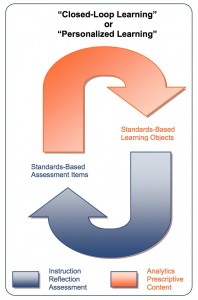Recently 1EdTech published a position paper entitled, “Evolving Personalized Learning: Maximizing K12 Expenditures to Support Instructional Reform” authored by Don Manderson of Escambia County School District, Florida. Don is a member of the advisory board of the 1EdTech I3LC (Instructional Innovation through Interoperability Leadership Council), which was set up by 1EdTech for school districts and states around the world to collaborate in leading the effective application of technology to K12. Here are the key takeaways from the paper - and below some introduction on how this relates to the global race to the top in education. 
As we often discuss in 1EdTech, the U.S. Department of Education initiated “Race to the Top” program has a very relevant name. While those in the U.S. might think of RTTT as a program to incentivize U.S. states to achieve instructional reform, the more significant “race to the top” is in terms of the global economy: the race among nations to compete more effectively and therefore prosper in the knowledge age.
However, at issue is how will reaching the top be measured? Well, certainly fixing the leaks in the pipeline of students who do not graduate at each level is one indicator. Another typical measure is scores on various standardized assessments. Unfortunately for the U.S. test scores and graduation rates relative to other countries have fallen dramatically over the last couple of decades.
The U.S. is investing heavily in the Race to the Top Assessment Program with the hope of achieving more authentic assessment that encourages more effective instruction – with the goal of improving the pipeline and scores – something that the previous U.S. government program “No Child Left Behind” failed at miserably.
However, the U.S. and every other nation need to carefully assess for itself what measures will really define “the top” as it relates to leading in the increasingly global and competitive world economy. What really matters in terms of global economic success and what does that imply for what a system of education can deliver? Not all educational experts are onboard with the theory that maximizing test scores should be the goal. For example, Yong Zhao, an educational scholar (and keynote speaker/panelist at 1EdTech Learning Impact 2013 in San Diego, May 13-16) has conducted research that leads to the conclusion that it is other factors that matter more, namely fostering diversity of talents, creativity, entrepreneurship, and passion.
The key point is that the global race to the top is as much about understanding what are the salient attributes of getting to the top as it is anything else. And, from my travels around the world I think it is safe to say that no country has figured this out yet. One common theme around the world: the need to move to personalized learning - something in 1EdTech we often call closed-loop learning - because personalization requires feedback and adaptation.
Personalized Learning = Closed-Loop Learning
Something the U.S. education system appears to have going for it is the acceptance of a diversity in approaches to “a better education.” The challenge with diversity is that it does not scale. Many points of light do not necessarily lead to a beacon of change. We see this in spades in education. There is no shortage of examples: really effective innovation here and there. But, if innovation is based on a particular teacher or a particular local approach, does it scale? Does grant funding of individual points of light create innovation that scales? I think history indicates that the answer is no, or at least very slow.
Therein lies the potential brilliance of the U.S. Race to the Top initiatives. Awards are relatively large sums of money to institute large-scale reforms. Will it work? Too early to tell – the next few years will be very interesting. But I do applaud the realization by the U.S. Department of Education that funding to create and implement scalable reforms is what is needed.
But if you are on the front lines, in a school district, should the race to the top be viewed as a good thing or more of a new burden from the top? After all, top down mandates from No Child Left Behind were a disaster. Will Race to the Top reforms be any different?
In the paper entitled, “Evolving Personalized Learning: Maximizing K12 Expenditures to Support Instructional Reform,” Don Manderson takes the positive side of the argument that in fact there is (perhaps, finally some) alignment occurring with respect to the personalized learning goals of teachers/students/parents and the top-down reforms via race to the top. The paper presents a holistic view. One in which the new Common Core State Standards provide a basis for enabling project-based learning to be more instructionally sound. At the core of the hypothesis is the need for interoperability – driving down the time and cost of integrating diverse digital resources to be available to teachers and students. An open vendor-neutral platform is the ONLY way this can be achieved in an evolvable, sustainable fashion. As such, an open vendor-neutral standards-based platform becomes a key element of “getting to the top” as districts, institutions and nations strive towards personalized and life-relevant learning that could potentially fix current leaks and create new vistas. In fact, it is difficult to imagine innovation in personalized learning that scales without the open, vendor-neutral, standards-based platform.
Until educational innovation gets ‘easy’ it won’t happen at the scale we need it to happen. Technology in service to education needs to be easy.
The paper presents a compelling vision – and 1EdTech is working closely with a set of leading districts and leading suppliers to put the open foundation in place. We thank the 1EdTech member organizations for taking the high road of collaboration on the next generation open platform for teaching and learning.



